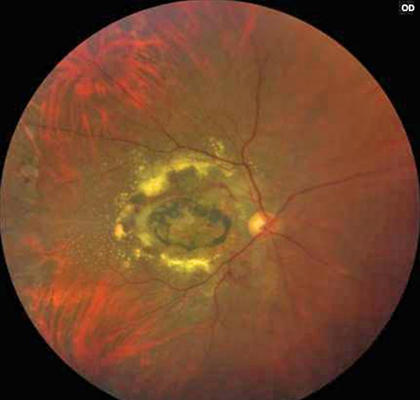
Dr Ridham Nanda
India is experiencing a dramatic demographic shift as the elderly population is projected to increase substantially in the coming decades. According to the United Nations Population Fund’s India Ageing Report 2023, the percentage of individuals (aged 60 and above) is expected to increase from 10.5% in 2022 to 20.8% by 2050. Currently, the proportion of geriatric population in India is around 10.5% of total population, with approximately 149 million people aged 60 years and above. Given the increasing geriatric population in India and the rising prevalence of age-related illnesses, it’s crucial to raise awareness about Age-related Macular Degeneration (AMD). February is observed as Age-related Macular Degeneration and Low Vision Awareness Month, highlighting the importance of early detection and management.
What is Age-Related Macular Degeneration (AMD)?
Age-Related Macular Degeneration (AMD) is a leading cause of vision loss among individuals over 60 years old. It affects the macula-the central part of the retina responsible for sharp, central vision.
AMD manifests in two primary forms:
4Dry AMD: The more prevalent type, accounting for 80-90% of cases. It involves the gradual thinning of the macula and the accumulation of tiny metabolic products called drusen. In advanced cases, these drusen can coalesce to produce geographic atrophy which can have poor visual prognosis.
4Wet AMD: Less common but more severe, this form is characterized by the growth of abnormal blood vessels beneath the retina, leading to leakage and scarring. This can lead to blindness in advanced cases.
AMD accounts for 8.7% of all types of blindness, globally and its prevalence in India is estimated to be between 1.4% and 3.1%.
What are the Risk Factors?
4Age: Individuals over 60 are at increased risk.
4Family History: A genetic predisposition can elevate the risk.
4Lifestyle Factors: Smoking, high blood pressure, obesity, and a diet rich in saturated fats (fried food, fast food) can contribute to the development of AMD.
4Sunlight Exposure: Prolonged exposure to UV light may increase the risk.
4 History of heart disease is another risk factor for AMD.
What are the Symptoms?
4Gradual loss of central vision in one or both eyes.
4A blind spot in the central vision.
4Distorted or wavy vision.
4Difficulty in driving.
4Difficulty recognizing faces or reading.
Diagnosis and Treatment:
All patients with AMD need specialized care with retinal experts. Complete fundus examination after dilation of pupil with dilating drops is required. Serial Fundus photography can be used to monitor the disease progression. Optical coherence Tomography (OCT) is a specialized machine used for detailed examination of various retinal layers. OCT can help in identifying the extent and severity of involvement and also monitor the treatment response. Fundus fluorescein and indocyanine angiography are specialized test used to delineate the lesion in retinal and choroidal layers, respectively. Various treatment modalities include –
4Lifestyle Modifications: Adopting a diet rich in antioxidants, maintaining a healthy weight, and avoiding smoking can help manage AMD.
4Multivitamins like vitamin C, vitamin E, zinc oxide, cupric oxide, omega -3 fatty acids and macular pigments lutein and zeaxanthin are recommended for dry AMD.
4Medical Interventions: For wet AMD, anti-VEGF (vascular endothelial growth factor) intravitreal injections are commonly used to inhibit the growth of abnormal blood vessels. These injections arrest the disease progression and can help in stabilising the vision. A wide variety of anti-VEGF injections are available; these injections are given inside the eye in sterilised environment. Multiple injections may be required to provide long lasting effects.
4Low Vision Aids: In advanced cases, devices like magnifying glasses can assist in daily activities.
AMD can have variable visual prognosis depending upon stage of disease, extent of involvement. Early cases of Dry AMD usually have good prognosis. Advanced disease especially wet AMD with extensive involvement usually has worse prognosis.
AMD- HIGHLIGHTS
4Age related macular degeneration is a progressive disease commonly seen in people with age greater than 60 years.
4Positive family history, smoking and exposure to UV light are risk factors for development of AMD.
4It can be of two types- dry and wet macular degeneration.
4Patients more than 60 years should get their complete ophthalmological which includes dilated fundus examination at least once year.
4Specialized test like Optical Coherence Tomography and fundus fluorescein angiography may be required for prognosticating and evaluating management options.
4Anti VEGF form the main stay of treatment in wet ARMD and multivitamin supplementation for Dry AMD.
(The author is Assistant Professor, Ophthalmology, AIIMS Vijaypur)

